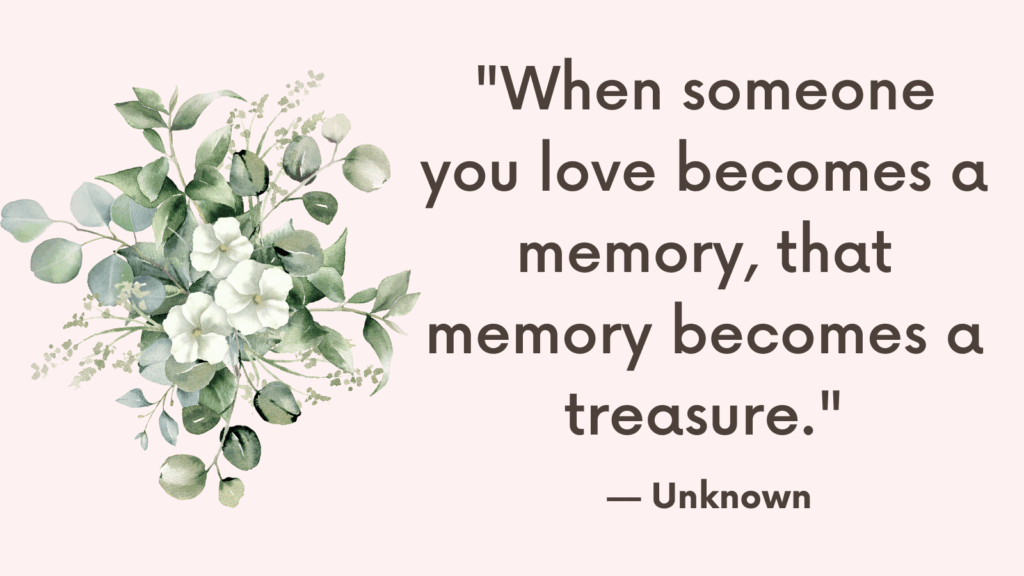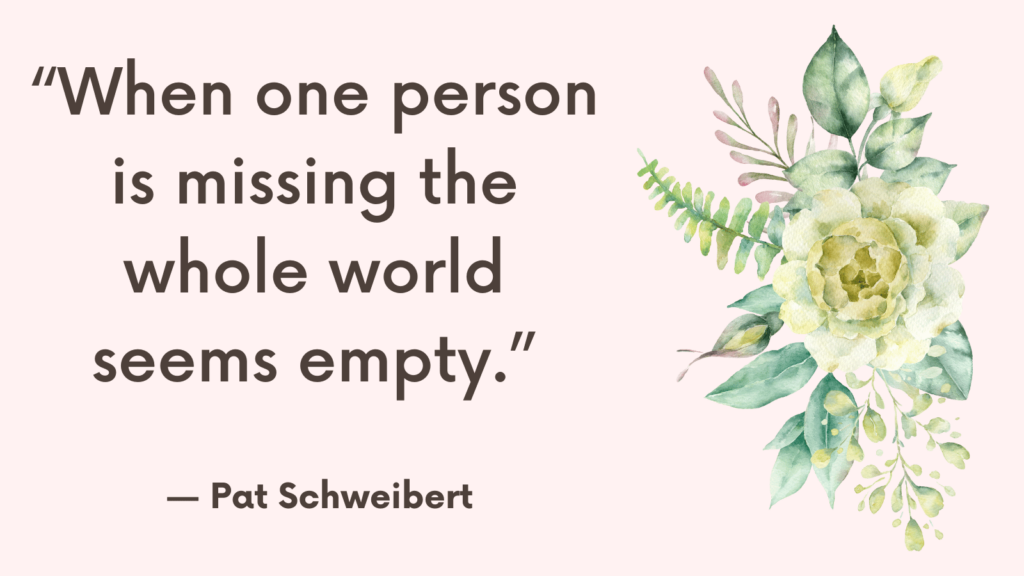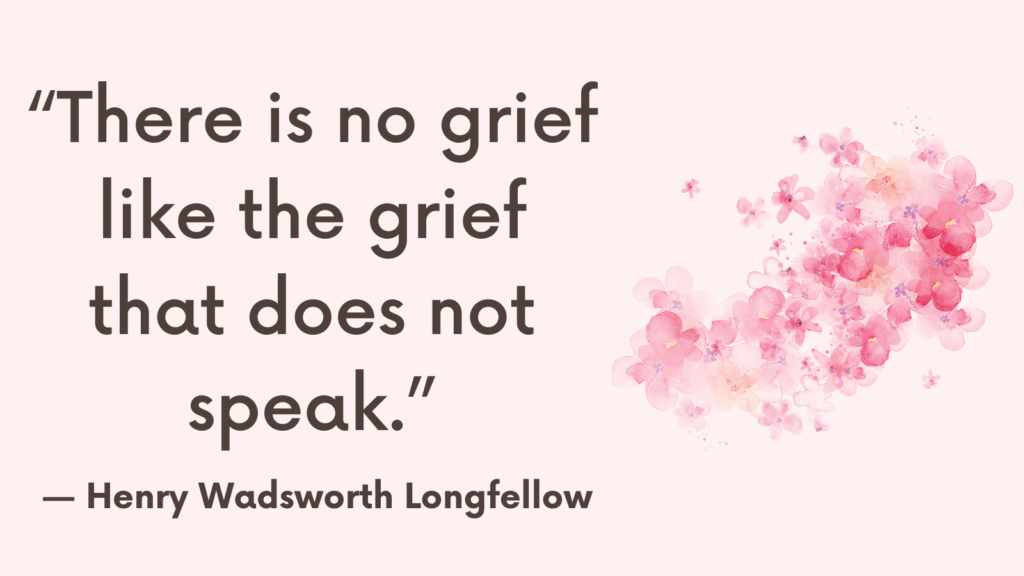Grief is just love with no place to go.
Losing someone we love can leave us feeling alone, empty, and hopeless.
If you’re grieving, you might wonder if your deep pain, sadness, or tears will ever stop.
No one around you seems to get it.
Your head is filled with unsettling questions of “Why?” and “Now what?”
Grief is not a disease to be “cured” or an illness to “get over.”
Grief is your response to loss and processing it is necessary.
As you outwardly express and release your grief, you’ll learn to adjust to and incorporate the loss of your beloved one into your life.
Top 12 Grief Lessons
Grief Lesson#1. The cultural “rules” about how grief is “supposed” to be handled don’t work.
Grief cultural rules include hiding your emotions, stuffing any feelings, numbing yourself, and pretending everything is okay.
Well-meaning people might encourage you to “be strong” and “move on,” but these messages only minimize your pain and invoke feelings of shame for not being able to move on as quickly and quietly as society expects.
If you’ve been grieving by the cultural rules, you know that this is how not to grieve.
Mourning shouldn’t be done quietly or quickly.
Mourning should follow natural, authentic guidance from your heart.
Related: Best 21 Grief Journaling Prompts (+FREE Grief Worksheets PDF)
Grief Lesson#2. Losing someone you love will alter your life forever.
Losing someone you love can bring you to your knees. You’ll need support and compassion to adjust to the ‘new’ normal of your life.
Grief is not something you’ll get over and then be “back to normal.” Grief is a transformative experience that helps you identify new priorities and meaning in your life.

Grief Lesson#3. You will not be the person you were before.
It’s not just your life that will change, you will also change.
Life changes you. You are not the same person after getting married, having children, switching careers, or getting divorced. Similarly, losing a loved one transforms you.
This is because your understanding of life, meaning, and purpose will change, and these make a huge part of your identity.
This doesn’t imply you’ll never be joyful again. It simply means that you learn to live with the physical loss of your loved one.
Related: Best +30 Grief Activities For Adults (+FREE Worksheets PDF)
Grief Lesson#4. If you had not loved so deeply, you would not feel pain so deeply.
Love and Grief are inextricably intertwined.
It’s your love for your loved one that created the pain, and no one should take away your love.
Grief means continuing to love that person, but understanding that their human presence is gone – you will love in separation.

Grief Lesson#5. You might feel like you’re losing it.
Feeling like you’re going crazy is a very common emotion after losing your loved one. You’re experiencing unfamiliar, intense emotions that you haven’t experienced before.
The loss of a loved one is a traumatic experience that can leave you confused and overwhelmed. Forgetfulness and brain fog are also commonly experienced when grieving.
These emotions are normal but they and are not permanent. Don’t apologize for them. You have the right to experience them in private or in public.
The more you release these emotions, the better you feel. Allowing yourself to cry, talking about these emotions, writing about them, will help you externalize your pain.

Grief Lesson#6. Grief is not something that passively descends upon you.
Healing after the loss of your loved ones requires taking a proactive approach.
It’s a conscious choice to decide to move through grief and heal.
Allow yourself to grieve in your own way be gentle with yourself, and take as long as you need.
Related: How To Help A Grieving Friend? 6 Things to Avoid Saying to a Grieving Person
Grief Lesson#7. Time alone will not heal grief.
Time might soften or even dull your pain but it’s what you do during this time that’s important.
Time alone won’t bring peace. It needs to be coupled with the conscious action to mourn.
You don’t just wait for healing to happen. You need to take an active approach. You need to honor, process, and integrate your painful emotions.

Grief Lesson#8. Grief isn’t a linear process.
It’s likely you’ve heard about the five stages of grief —denial, anger, bargaining, depression, acceptance—described by Dr. Elisabeth Kübler-Ross in her book, On Death &Dying. Many people don’t know that these stages were conceived in the context of terminally ill patients learning to accept their own impending death.
They have misconstrued the model to suggest grief can be healed by progressing through these sequential stages.
Do not try to fit your grief into a rigid framework. Grief is not as smooth and straight progression as most people assume.
There is no “right” way to grieve.
Grief Lesson#9. Grief doesn’t follow any timeline.
There is no acceptable amount of time to grieve. Both, the intensity and duration of grief are unique to you, your relationship with your loved one, and the circumstances of death.
Most people may expect grief to be over within a year. But grief is not bound by time.
You can’t “speed up” your healing and any attempts to move away from your pain or keep yourself busy will only prolong your suffering and risk carrying unresolved grief forward into the years ahead.

Grief Lesson#10. Out twenty-first-century culture perpetuates denial and avoidance of grief.
Most people are afraid to talk or think about loss. They don’t want to admit unexpected death is real and can happen to anyone. They don’t want to be reminded of their mortality.
Due to this fear, no wonder you feel alone and hesitant to talk about your loss. But this can only impede your healing.
Allow all your responses and emotions. Let others know it’s okay to talk about your loss and the life of your loved one.
Don’t be afraid to mention your loved one’s name. Openly share memories. See it as a privilege and responsibility to keep your loved one’s memory alive.
Grief Lesson#11. Death doesn’t end the relationship.
Whether you are religious or not, most of us believe people who die still exist in some form.
Your loved one’s physical presence is no longer with you, but your relationship continues.
Ashley Davis Bush wrote, “Death doesn’t end the relationship; it simply forges a new relationship—one not based on physical presence but on memory, spirit and love.”
This connection can facilitate healing by providing solace, comfort and support as you transition from the past to the future.
Grief Lesson#12. It’s not just the person you lose.
When your loved one dies, you don’t just lose the person. You lose your role, responsibilities in the relationship, the routine and habits, the companionship and intimacy, the lifestyle, income, interests, etc.
There are also less intangible losses involved, such as your sense of purpose, identity (the way you see yourself and relate to others), confidence and self-esteem, your hopes and future plans, your sense of security, and your mental and emotional balance.
The more you had with the person, the more you will feel the impact of your loss.
Does that mean that if you didn’t love so hard, you wouldn’t have felt so much pain? Probably, but do you believe that your love and what you had with that person wasn’t worth it?
Related: Resilient Grieving: Best 17 Ways To Manage Grief In The Workplace (+FREE Grief Worksheets)

Practical Grief Action Plan
Why Must You Express Your Grief?
You may ask, “Can’t I just ignore my grief and get on with my life?”
The truth is when a powerful feeling, such as grief is ignored or suppressed, it usually comes out in disturbing forms: nightmares, flashbacks, intrusive thoughts, anxiety and even panic attacks, depression, addictions, fits of unexplained anger, stomach ulcers, weight loss (or gain), etc.
On the other hand, acknowledging your feelings of grief and expressing them will help you release the pain and move on with your life sooner.
The following is a list of activities that will help you through your grief journey. You can choose an activity every day. You can also repeat the activities as much as needed.
Related: Grieving Someone Who Is Still Alive – Ambiguous Grief
Activity 1 – Create a Mantra
Consider coming up with a mantra that encourages you to take it one day at a time.
The following are some examples:
“I am strong enough to embrace my grief.”
“Allowing myself to feel is allowing myself to heal.”
“Letting go is not forgetting, it is opening my heart and releasing the pain.”
“Just do the next right thing.”
Write down your mantra and hang it where you’ll see it often.
Activity 2 – Survive for The Next 60 minutes
After a loved one dies, thinking about the future can be overwhelming.
Just try to make it through the next 60 minutes. When that feels comfortable enough, try making it through the next two hours, or from mealtime to mealtime.
Then try making it through a whole day. Before you know it, a whole week will have passed.
Activity 3 – Exercise
Physical exercise is scientifically proven to boost mood.
Try walking for 20 to 30 minutes a day and see how moving affects your grief.
While you don’t have to walk outside, fresh air and nature can boost your mood. Nature can also help you get out of your head by noticing the beauty of nature around you.
Walking can also create the valuable illusion that you’re “going somewhere” while grieving.
If they loved gardening, plant a memory garden in their honor. If they loved animals, set up a recurring donation to an animal charity or volunteer your time at an animal shelter.
Related: Suicide Grief Stages – How Are They Different? (+10-Step Guide To Grieve Suicide Loss)
Activity 4 – Dealing With Anxious Thoughts
Loss can trigger feelings of anxiety.
For each negative thought or anxious “what if” that crosses your mind, think of a thought that counters that one.
For example, if you think “My friend died, what if another friend dies,” pair it with, “My friend died, maybe my other friends will live to be a hundered.”
Related: Anxiety Relief: How to Treat Anxious Symptoms and Thoughts Effectively?
Negative Thoughts Worksheets
Activity 5 – Allow Feelings of Confusion and Forgetfulness
Grief can leave you feeling confused, forgetful, and overwhelmed.
When you’re feeling that way, think about all the tasks you do in a day and add “while grieving.”
If you forgot an important meeting, you can let yourself off the hook: “I forgot my meeting…while grieving.”
Activity 6 – Tell Your Grief Story
Telling your story can help get you out of the initial shock of losing your loved one and help you realize that you’re not alone.
Write down your grief story for yourself and share it with others who are experiencing similar pain.
Use GriefShare to find grief support near you.
Activity 7 – Allow Your Tears to Flow
Allow yourself to cry without having the need to have a “why” for your tears.
Grief and missing your loved one is worth crying about over and over and over again.
Each time you feel that pressing lump in the back of your throat, say to yourself, “It’s okay to cry. Nobody cries forever. There will be an end to this.”
Related: 6 Simple Ways to Manage Difficult Emotions and Control Them
Activity 8 – Practice Self-Care
Recovery has a lot to do with the “micro” than the “macro.”
Make the time every day to practice a self-care activity. It doesn’t have to be hours, even 10 minutes can be enough.
Take a walk, meditate, writing in a journal, do a deep breathing exercise, enjoy some tea, put on a mask, read your favorite book, watch something funny, etc.
Related: 45 Easy Self Care Day Ideas at Home for a Healthy Mind, Body & Soul
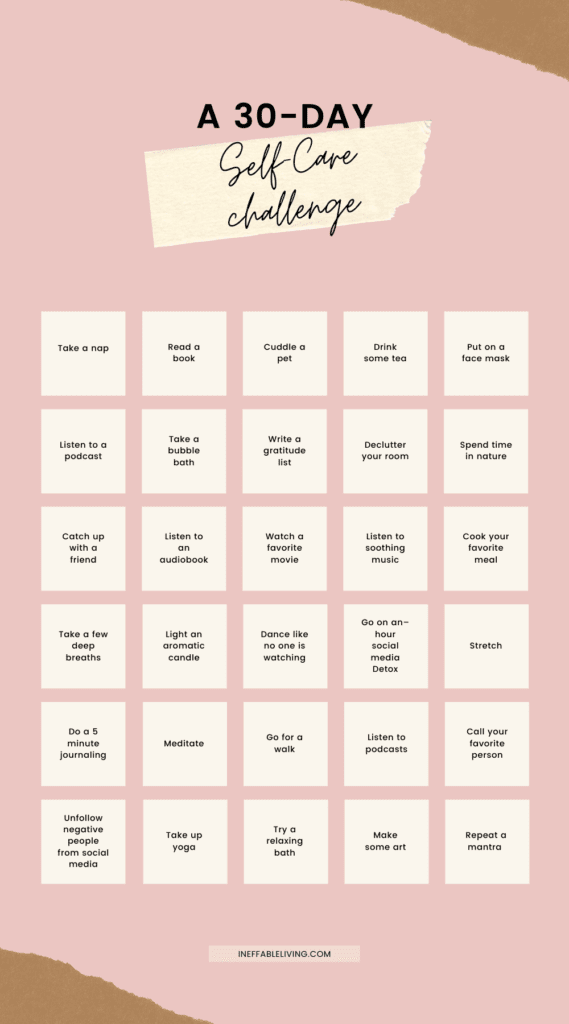
Activity 9 – Face Your Losses
Losing a loved one is a primary loss.
Secondary losses are all the things we lose because of our primary loss.
There are three types of secondary loss:
- Immediate: losses you experience right when your loved one dies, such as “our night routine”;
- Gradual: losses you experience over time, such as “my financial stability”; and
- Unexpected: losses that seem to come up out of nowhere, such as “my memory of an old family recipe”.
On a piece of paper, draw three columns and label them “Immediate,” “Gradual,” and “Unexpected.”
In each column, write down secondary losses you’ve experienced.
Activity 10 – Create a List of Things You Loved About Your Loved One
Make a list of 5 to 10 things you loved about your departed loved one.
This list may include the way they laughed, the way said your name, etc.
These things can be small and meaningful reminders of your loved one’s specialness.
Activity 11 – Check In With Yourself
On those times when you feel unseen by the people around you, practice seeing yourself by checking in with yourself.
In your journal answer the following question, “What do I feel right now that I wish somebody would just understand?”
Allow yourself to let your feelings pour out onto the page.
Once you’re done, write down or say out loud, “I see you. I hear you. What you’re feeling makes sense given your grief.”
Related: Top 21 Emotional Writing Prompts To Process Emotions
Activity 12 – Meditate
Try this meditation at the end of the day or whenever you need to relax.
1. Close your eyes and take a few deep, calming breaths.
2. Imagine the wounds of your grief. Be it a weight on your shoulders, a hole in your chest, or whatever it feels like to you.
2. Find grief in your body and allow yourself to feel it.
3. When you’re ready to let go, imagine an inner supporter. This could be a real person or an imaginary one. It could be a human, an animal, or even a fairy.
4. Visualize that inner supporter working on your wounds, applying stitches, ice, a light, or whatever is needed for your wounds to heal.
Activity 13 – Face Your Fears
Think of fears you’re living with. In your journal write down, “The fear I’m living with today is[insert fears].”
List every fear you have: for example “the fear that my life will always look like this,” or, “the fear that I will never love again.”
Then below each fear, write down, “I am choosing to show bravery by [insert actions],” and list the ways that can help you move forward despite the fear, knowing that fear and bravery are allowed to coexist: for example, “Getting out of bed,” or, “Attending grief support groups.”
Related: How to Overcome Fear In Life? 5 Actionable Steps To Conquer Fear And Get Unstuck
Activity 14 – Feel Safe Again
Losing your loved one can rob you of your sense of safety and security.
Try making a list of people, things, places, and activities that help you feel secure and grounded.
Each time you feel uncertain or unsafe, choose an item from your list to engage with.
What felt safe before your loss may not feel safe now, and vice versa. Keep looking for more things that make you feel safe and bring you peace of mind.
Activity 15 – Go to a Safe Place
Plan safe places you can go to when you feel overwhelmed or need a little break.
This could be a room in your house, a space at work, a space at the mall, or your car.
Activity 16 – Picture Grief As A Real-Life Person
Picture grief as a real-life person, and try speaking to it as you would speak to a friend, knowing that grief is trying to help you transition after your loss.
You can even draw a picture of what grief looks like to you.
You might discover that grief is not threatening or bad, just present.
Activity 17 – Keeping Your Memories Of Your Loved One Alive
Using your imagination or an online word generator, make a list of 50 random words, such as flower, dinner, dance, dress, etc.
Once a week, choose a word from your list and call forth a memory related to that word.
Activity 18 – Honor Their Memory
You find yourself having to say goodbye to your departed loved one over and over and in different ways.
Searching for ideas on how to honor your lost loved one’s memory, think of some things they loved or enjoyed in life.
Activity 19 – Connect With Other People
Connecting with other people can be healing, especially in times of grief.
Pick out a greeting card and write a thoughtful note to a friend. If you’re stuck for prompts, consider thanking them for their support during this tough time.
Related: Struggling to Receive? 7 Steps to Open Up and Start Accepting Loved and Support
Activity 20 – Do Something Kind For Another Person
Studies show that performing an act of kindness actually improves our mood.
Give a compliment or a warm hello, help someone carrying their groceries, take care of your neighbor’s dog when he goes for a vacation, genuinely greet waiters and leave a good tip every now and then, bring your co-worker a coffee, etc.
Picture the recipient of your kindness as your loved one.
Activity 21 – Ask a Friend to Tell You About Their Loss
Grief can be an isolating experience.
If you find it difficult to reach out, when a friend asks you if they can do anything for you, ask them to tell you a story of a time in their life when they faced loss.
You may discover that you’re not alone in this and that if people survived extraordinarily difficult circumstances, so could you.
Activity 22 – Read Other people’s Grief Stories
Solace can be found in the stories of those who have gone through what you’re going through now.
Search for books and memoirs on grief and loss by people you admire.
Let every person’s recovery story boost your hope that you too will recover eventually.
Activity 23 – Try Listening to Audiobooks and Podcasts
If you’re struggling to read books because of your grief, try listening to audiobooks and podcasts whether they were grief-related or not.
Hearing another human’s voice can be comforting.
Check out the following podcasts:
- The Mindfulness & Grief Podcast (Apple/Spotify) hosted by author and thanatologist Heather Stang
- Grief Out Loud (Apple/Spotify) hosted by Jana DeCristofaro
- What’s Your Grief Podcast (Apple/Spotify) hosted by Eleanor Haley and Litsa Williams
- Grief Encounters (Apple/Spotify) hosted by Venetia Quick and Sasha Hamrogue
Activity 24 – Develop a Ritual In Their Honor
One great way to keep your relationship with your lost loved one alive is to develop a ritual in their honor.
This can be private, such as lighting a candle in your bedroom or public, such as running a 5K each year.
Choose a ritual that will help you feel connected to your loved one.
Activity 25 – Resilience Inventory
Set a calendar reminder for six months from now to check in with yourself and your grief journey.
Include the following questions to answer:
“How have I grown in six months?”
“What do I know now that I didn’t know then?”
Taking this resilience inventory helps recognize your progress and ability to be resilient, and honor the small and large things you’ve learned in your grief.
Free Printable Worksheets For Grief (PDF)
What’s Next? Recovering From Grief: How to Get Back to Life After Loss
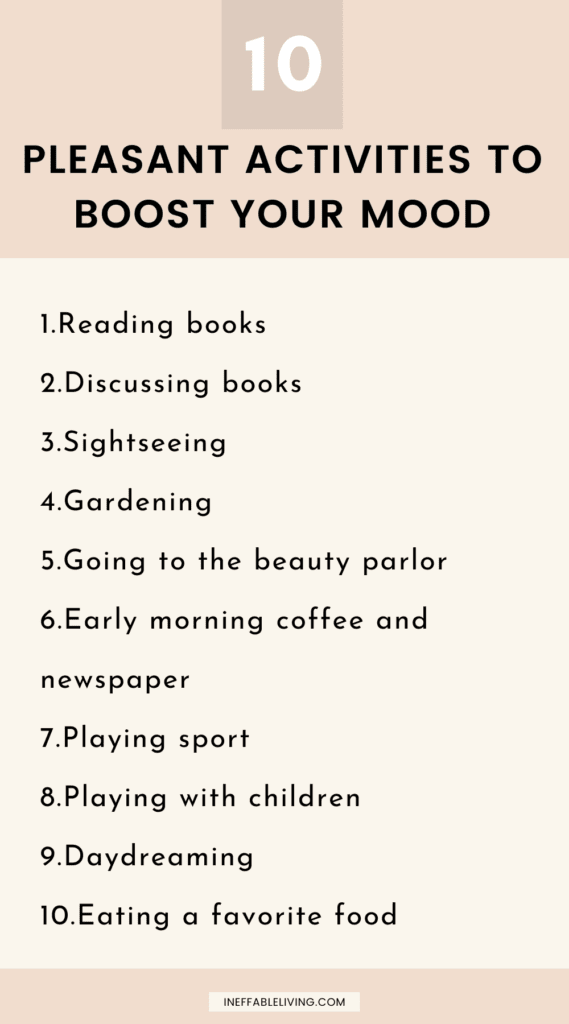
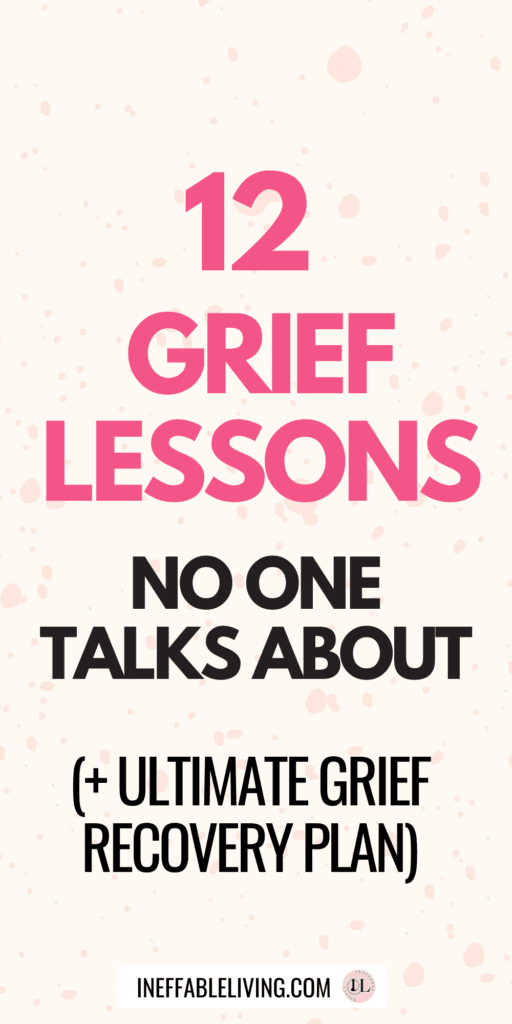
Resources
- Portions of this article were adapted from the book The Sudden Loss Survival Guide: Seven Essential Practices for Healing Grief, © 2020 by Chelsea Hanson. All rights reserved.
- Portions of this article were adapted from the book Your Grief, Your Way, © 2020 by Shelby Forsythia. All rights reserved.
- Grief – Wikipedia
- Grief | Psychology Today
- The Five Stages of Grief (verywellmind.com)
- Grief: Physical Symptoms, Effects on Body, Duration of Process (webmd.com)
- Coping with Grief and Loss – HelpGuide.org
- Grief: Coping with the loss of your loved one (apa.org)
- The Biology of Grief – The New York Times (nytimes.com)
- Grief: A Brief History of Research on How Body, Mind, and Brain Adapt – PMC (nih.gov)
- The effect of bereavement groups on grief, anxiety, and depression – a controlled, prospective intervention study | BMC Palliative Care | Full Text (biomedcentral.com)
- Frontiers | A Qualitative Study on the Grief of People Who Lose Their Only Child: From the Perspective of Familism Culture (frontiersin.org)
- How grief and loss affect your brain, and why it takes time to adapt : Shots – Health News : NPR
